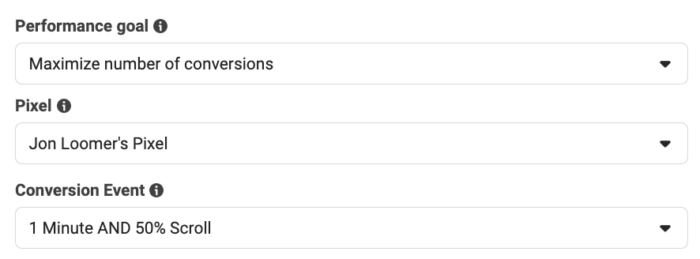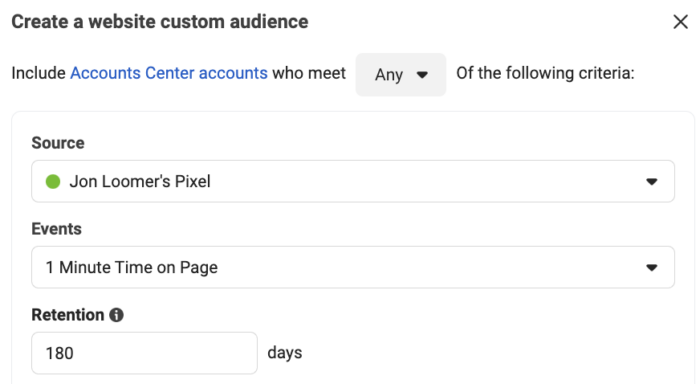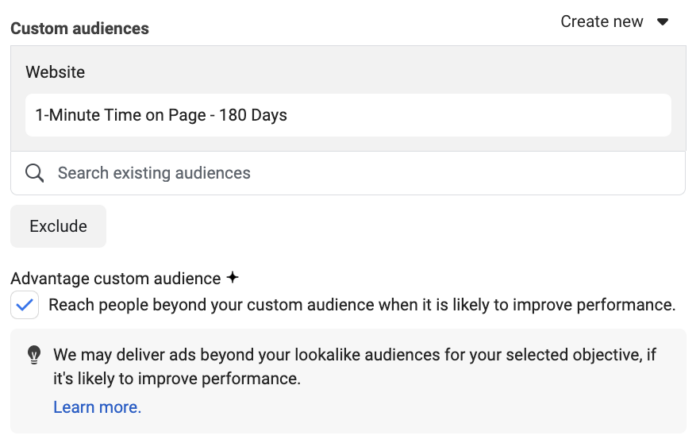I’ve used custom eventsConversion events tracked by the pixel, app SDK, or API that are outside of standard events. These tend to be created to fit the publisher's needs when a pre-defined standard event will not. More for years now, and it’s always felt like a secret underworld of Meta advertising. It’s as if custom events are seen as being too complicated to even bother, if advertisers know about them at all. But the advantages are undeniable.
In this post, you’ll learn:
- What custom events are
- How I add custom events
- Examples of custom events
- Benefits of custom events
Buckle up, this is a good one…
What Are Custom Events?
The best way to explain custom events is by defining some basic Meta ads conversion terminology.
1. Events. Events (or conversion events) are important actions that happen on your website, in your store, or in your CRM. You send event information with your pixel data to Meta, for example, and highlight events to signify, “HEY! This is an important thing that I care about.”
NOTE: We’ll focus on the pixel applications of custom events in this post.
2. Standard Events. Standard events are the predefined actions that fit within a universal category. Examples include Purchase, Lead, Search, and Complete Registration. Meta has lots of data on these actions because advertisers around the world use standard events to define important actions.
3. Custom Events. Custom events are important actions that fall outside of Meta’s predefined standard event categories. We’ll get to examples of these in a moment, but you define and name them yourself. It could be an action like scrolling down a page, engaging with a specific piece of media, or clicking on a certain image or button.
4. Custom ConversionsCustom conversions let you create rules for events or URLs so that you can better track and optimize for specific actions with Facebook ads. More are NOT Custom Events. Typical confusion arrises here because advertisers often look at custom conversions and custom events as being interchangeable. While they both signify a conversion of some kind, the similarities stop there. Custom conversionsA conversion is counted whenever a website visitor performs an action that fires a standard event, custom event, or custom conversion. Examples of conversions include purchases, leads, content views, add to cart, and registrations. More are created within the Events Manager interface using rules. Custom events typically require additional code with your pixel.
How I Add Them
There are many different ways that you can send conversion events to Meta, whether it be via the pixel or API. But I use Google Tag Manager to manage my pixel and create these events.
The process for adding standard and custom events using Google Tag Manager is mostly the same. You create a tag that includes the unique script for the event and you add a trigger that defines when this event will fire.
Here’s a simple example of a Complete Registration standard event tag in GTM (without parameters to keep it simple)…

And here’s a simple example of a custom event tag for a 2-minute visit…

We define what the tag is that is sent to Meta. In one case, I used a predefined label (Complete Registration). In the other, I used my own.
Examples
There are endless possible examples of custom events because they are whatever it is you define them to be.
Consider this: You’re looking over a potential customer’s shoulder while they visit your website. What are the things you hope they’ll do that fall outside of the standard event definitions?
Yes, you want people to complete a purchase or fill out your form. Dig deeper. What else is important to you?
As a blogger, there’s a long list of actions that I care about that signify quality engagement. Here are some examples…
1. 1-Minute Time on Page. One signal that you’re deeply engaged with my content is the amount of time you spend on a page. I fire events at 1, 2, and 3 minutes.
2. 50% Scroll Depth. You could spend 3 minutes on a page, but it doesn’t mean anything without scrolling. I have an event that fires once you’ve scrolled halfway down a page, but it could be based on another percentage or a specific number of pixels.
3. Embedded YouTube Video Play. One of my favorites. I embed videos at the bottom of many of my blog posts (including this one!), and an event fires when they’re played. This is possible (and easy) because both Google Tag Manager and YouTube are Google products. You can pass the title of the video and amount of time watched using parameters.
4. Internal Link ClicksThe link click metric measures all clicks on links that drive users to properties on and off of Facebook. More. Another signal of engagement is someone who views multiple pages of my website while visiting.
5. External Link Clicks. I also include external URLs, where appropriate. But this may be especially useful if you link out to a third-party website for a product that you sell.
6. Referral. I’ve created referral events that fire if someone comes from Google or a Meta property. I’ve found that Google visitors have value since they are often looking for an answer to their question. The Meta referrals are useful because I can compare these events to the reported Outbound ClicksOutbound clicks measure the number of clicks on ads that take people to properties away from Facebook. More in Ads Manager.
7. Start Embedded Audio Player. I don’t do this as often these days, but I have an embedded audio player at the top of many of my blog posts to play a related podcast episode or audio version of the post. It’s another great signal of deep engagement.
8. Social Share. Ads Manager will tell us how many times our ad was shared to Facebook or Instagram, but I have social share buttons that go other places as well. When people click those buttons, an event is fired.
9. Comments Visibility. This could be seen as an extension of the scroll event. If you scroll so far that the comments are visible, you are (probably) deeply engaged.
10. Combo Event. You can also combine multiple events into a single combo event that only fires when all of those things happen. The classic example is if someone spends one minute AND scrolls at least halfway down a page. But I also have a custom event for anyone who spends 3 minutes, scrolls, and clicks an internal link.
Benefits
Okay, great. We created these events. Now what?
There are three primary things that we can do with this…
1. Enhanced Reporting. One of my favorite things about custom events is the added context that they can provide to reporting. Ads Manager tells us the number of clicks and conversions, but what do you do with this information when you aren’t getting the purchases or leads you were wanting?
Custom events can help verify whether people go to your landing page and are disinterested and leave or if they actually hang around and do other things — even if they didn’t buy.
2. Enhanced OptimizationThe Performance Goal is chosen within the ad set and determines optimization and delivery. How you optimize impacts who sees your ad. Meta will show your ad to people most likely to perform your desired action. More. If you’re a content creator who wants to send quality traffic to your blog posts, you know how challenging that is with Meta ads. If you run Traffic campaignsThe campaign is the foundation of your Facebook ad. This is where you'll set an advertising objective, which defines what you want your ad to achieve. More optimized for link clicks or landing page viewsLanding Page View is a Facebook ads metric that represents when people land on your destination URL after clicking a link in your ad. More, you can bet you’ll get lots of low-quality traffic.
The reason is that Meta thinks that you only care about the traffic. But if you define the event you want, the algorithm can do a better job of sending the actions that make you happy.

3. Enhanced Targeting. Broad targeting is all the rage now, but there’s still room for some remarketing. You can create website custom audiencesA website custom audience matches people who visit your website with people on Facebook. You can then create ads to show to that audience. More based on custom events.

You could then either target those people or use it as the starter when using Advantage Custom Audience or Advantage+ Audience.

Get Started
If you want to take custom events further, I have some great resources for you.
1. Custom Event Mastery Training. It’s 24 lessons in all and includes the step-by-step instructions for creating many of the events mentioned in this post as well as how you’d leverage them.
2. Intro to Custom Events. If you want to go slowly, you can subscribe to the first four lessons for free, which walk you through how to get Google Tag Manager set up to use your pixel.
Watch Video
I recorded a video about creating custom events for quality traffic, too. And if you watch the video, a custom event will fire!
Your Turn
Are you using custom events? What are some creative ways you’re using them?
Let me know in the comments below!






